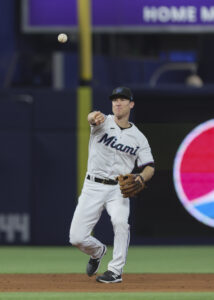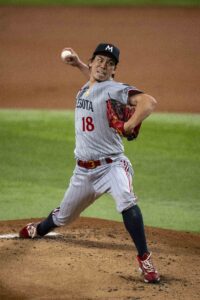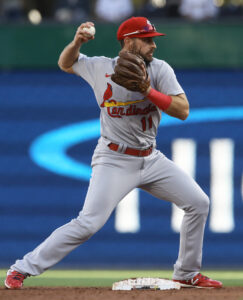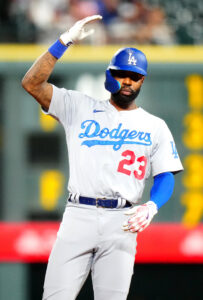November 30: Wendle passed his physical and the deal is now official, per Andy Martino of SNY. Wendle can also earn an extra $500K in bonuses, per Joel Sherman of The New York Post, with $100K for getting to 250, 300, 350, 400 and 450 plate appearances.
November 29: A few hours after agreeing to terms with Luis Severino, the Mets have added infield depth. New York is reportedly in agreement with Joey Wendle on a one-year, $2MM guarantee. The deal also contains performance bonuses for the Excel Sports Management client.
Wendle, 34 next April, has spent the last two years in the NL East as a member of the Marlins. His tenure with the Fish didn’t go as planned. Miami acquired the left-handed hitter from the Rays over the 2021-22 offseason. He’d had a solid four-year run in Tampa Bay, hitting .274/.330/.414 and earning an All-Star nod in his final season. Miami installed him as their primary third baseman for the ’22 season.
His offensive numbers took a sharp downward turn. Wendle hit .259/.297/.360 with only three home runs through 371 trips to the plate. Miami brought in Jean Segura to play third base last offseason but kept Wendle in the Opening Day lineup, kicking him up the defensive spectrum. After trading Miguel Rojas to the Dodgers, the Marlins turned to Wendle as their primary shortstop.
Wendle had an even tougher year. He hit .212/.248/.306 over 318 plate appearances. He connected on only two homers while his strikeout rate jumped from 13.5% to a nearly average 21.1% clip. Of the 293 hitters with 300+ trips to the plate, none had a lower on-base percentage than Wendle. His slugging mark was ninth-lowest among that group. The Fish stuck by Wendle as their primary shortstop, although he struggled significantly down the stretch. He hit .142/.176/.201 in the season’s second half.
To his credit, Wendle handled his more demanding defensive responsibilities. He logged a career-high 754 1/3 innings at shortstop, no small feat for a player in his age-33 season. Defensive Runs Saved rated him highly, estimating he was six runs above average at the position. Statcast’s Outs Above Average metric was more bearish, grading him three runs below par.
Barring injury, Francisco Lindor will take almost every shortstop inning next season. Wendle can handle a utility role off the bench. Public defensive metrics have always graded Wendle highly at second base and pegged him as a solid defender at the hot corner. As a defense-first lefty hitter with the ability to handle multiple infield spots, he’s more or less a direct replacement for Luis Guillorme. The Mets non-tendered the latter two weeks ago.
A $2MM guarantee brings the Mets’ payroll projection around $276MM, as calculated by Roster Resource. Their competitive balance tax number jumps a little north of $289MM. New York is within the third tier of luxury penalization, roughly $8MM below the $297MM mark that represents the fourth and final tier. Given remaining needs on the pitching staff and in the corner outfield, they seem likely to surpass that threshold by the time the offseason concludes.
Since they’re presently in the third tier and have paid the luxury tax in each of the past two seasons, the Mets are charged a 95% rate on their expenditures. Adding Wendle comes with $1.9MM in taxes, bringing the total cost to $3.9MM. If/when they pass the $297MM figure, they’d be taxed at a staggering 110% rate on each additional dollar spent.
Andy Martino of SNY first reported the Mets were in discussions with Wendle. Robert Murray of FanSided was first to report an agreement had been reached. Mark Feinsand of MLB.com reported the approximate $2MM base salary and the presence of unspecified performance bonuses. Joel Sherman of the New York Post pegged the guarantee at exactly $2MM.
Image courtesy of USA Today Sports.


 Severino, 30 in February, is a wild card of this winter’s free agent market. He once looked like one of the best pitchers in the majors but has spent the past five years either injured or ineffective or both. He made 63 starts over 2017 and 2018, throwing 384 2/3 innings with a 3.18 earned run average. He punched out 28.8% of batters faced while walking just 6.2% of them and keeping 45.8% of balls in play on the ground. FanGraphs calculated him as worth 11 wins above replacement over that two-year span, trailing just four pitchers around the league:
Severino, 30 in February, is a wild card of this winter’s free agent market. He once looked like one of the best pitchers in the majors but has spent the past five years either injured or ineffective or both. He made 63 starts over 2017 and 2018, throwing 384 2/3 innings with a 3.18 earned run average. He punched out 28.8% of batters faced while walking just 6.2% of them and keeping 45.8% of balls in play on the ground. FanGraphs calculated him as worth 11 wins above replacement over that two-year span, trailing just four pitchers around the league:  This offseason marked the end of the incentive-heavy, eight-year, $25MM deal Maeda signed with the Dodgers back in January 2016, when Maeda first came to the majors from Nippon Professional Baseball. Maeda’s earning power at the time was somewhat limited due to some concerns over his elbow, though he didn’t have any major arm-related injury issues over four years in Los Angeles before the Dodgers dealt him to the Twins during the 2019-20 offseason. Maeda responded with an outstanding performance in the pandemic-shortened campaign, posting a 2.70 ERA in 66 2/3 innings and finishing second in AL Cy Young Award voting.
This offseason marked the end of the incentive-heavy, eight-year, $25MM deal Maeda signed with the Dodgers back in January 2016, when Maeda first came to the majors from Nippon Professional Baseball. Maeda’s earning power at the time was somewhat limited due to some concerns over his elbow, though he didn’t have any major arm-related injury issues over four years in Los Angeles before the Dodgers dealt him to the Twins during the 2019-20 offseason. Maeda responded with an outstanding performance in the pandemic-shortened campaign, posting a 2.70 ERA in 66 2/3 innings and finishing second in AL Cy Young Award voting. Signing the 30-year-old DeJong is a clear buy-low move for the Sox, as he has struggled badly in recent seasons. He had an incredible debut with the Cardinals in 2017, hitting 25 home runs in his first 108 major league games. His 28% strikeout rate and 4.7% walk rate were not great, but his overall line of .285/.325/.532 translated to a wRC+ of 123.
Signing the 30-year-old DeJong is a clear buy-low move for the Sox, as he has struggled badly in recent seasons. He had an incredible debut with the Cardinals in 2017, hitting 25 home runs in his first 108 major league games. His 28% strikeout rate and 4.7% walk rate were not great, but his overall line of .285/.325/.532 translated to a wRC+ of 123.
